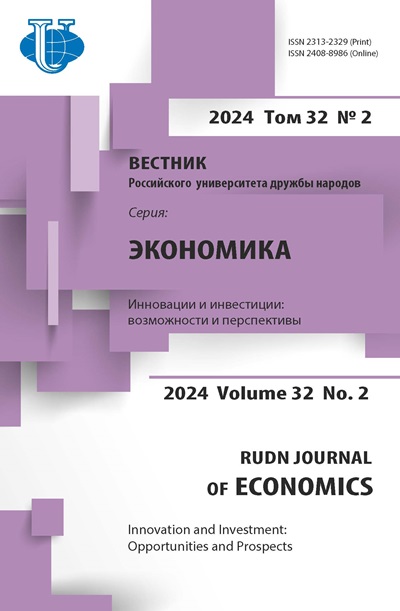School education reform in India 2020: Economic prerequisites and purposes
- Authors: Gubina M.A.1,2
-
Affiliations:
- Saint-Petersburg State University
- Russian Presidential Academy of National Economy and Public Administration (RANEPA)
- Issue: Vol 31, No 4 (2023): EDUCATION. SCIENCE. DIGITALIZATION
- Pages: 760-778
- Section: INDUSTRIAL ORGANIZATION MARKETS
- URL: https://journals.rudn.ru/economics/article/view/37310
- DOI: https://doi.org/10.22363/2313-2329-2023-31-4-760-778
- EDN: https://elibrary.ru/SGZQRQ
Cite item
Full Text
Abstract
In 2023, India surpassed China in terms of population, becoming the most populous country in the world. Many experts emphasize that India has a demographic dividend, which allows for high rates of economic growth. However, millions of young people enter India’s labor market each year, a significant portion of whom lack basic education and can only be engaged in low-skilled jobs. This situation affects the quality of life, working conditions, and overall socioeconomic situation in the country. The Government of N. Modi, along with other reforms relevant and timely for India, has developed a comprehensive transformation of basic and higher education in the country. The objective of the research is to identify the economic prerequisites, tasks, and methods for implementing the reform of the basic education system. It has been identified that despite the 2002 amendment to the Constitution and the Right to Education Act passed in 2006, many families do not send their children to school, and in other cases, some children do not complete their education. This is due to several reasons, including the remoteness of schools, difficulty in entrance and transfer exams, the need to help parents, among others. The new National Education Policy of 2020 aims to provide holistic early childhood and school education. The traditional structure of the education system has been changed: preschool education is now incorporated into the education system, allowing kindergarten graduates to transition smoothly into school. The traditional 10+2 model has been replaced with a 5+3+3+4 model. Regional languages are given special importance - education will be conducted in the mother tongue up to the fifth grade, and then students will also learn Hindi and English. Age-appropriate teaching methods are applied at each stage of education. In the final stage of schooling, students are given the freedom to choose disciplines based on their interests. Each stage of education aims to develop critical thinking, the ability to engage in discussions, and case analysis. Thus, the education system reform, if successfully implemented, aims to provide India’s economy with a higher quality workforce, regardless of whether the school graduate continues their education in college or enters the labor market after completing school.
About the authors
Maryana A. Gubina
Saint-Petersburg State University; Russian Presidential Academy of National Economy and Public Administration (RANEPA)
Author for correspondence.
Email: m.gubina@spbu.ru
ORCID iD: 0000-0003-0672-8097
PhD (Econ.), Associate Professor of the Department of World Economy, St Petersburg State University; Associate Professor of the Department of Economics, North-West Institute of Management, Branch of RANEPA
7-9 Universitetskaya Embankment, St. Petersburg, 199034, Russian Federation; 57 Sredny Avenue of Vasilievsky Island, St. Petersburg, 199178, Russian FederationReferences
- Azad, J.L. (2014). Evolution of Indian Education: From Colonial Stranglehold to Resurgent India (A Critical Study, in an Historical Perspective, of The Development of Indian Education During the Period 1813 to 2013). Gyan Publishing House.
- Bhimbat, L.D., Wadehra, R. (2011). Evolution of Education in India: A Historical Perspective. Ukay Publishing Co.
- Galistcheva, N.V. (2020). The Role of Small-Scale Industries in Achieving the Sustainable Development: the Experience of India. MGIMO Review of International Relations, 13(3), 151–169. (In Russ.). https://doi.org/10.24833/2071-8160-2020-3-72-151-169
- Gubina,M.A. (2019). Import Substitution and/or Export Orientation: the Case of Indian Pharmaceutical Industry. St Petersburg University Journal of Economic Studies, 35(2), 197–222. https://doi.org/10.21638/spbu05.2019.202
- Krishna, A.H., Sekhar, M.R., Teja, K.R., & Swamy, B.A. (2017). Primary education during pre and post right to education (RTE) act 2009: An empirical analysis of selected states in India. International Journal of Humanities and Social Science Invention (IJHSSI), 6(11), 41–51.
- Radchenko, L.R. (2020). Formation and development of higher education in India [thesis abstract]. Ulyanovsk: Ulyanovsk State University, 50 p.
- Suprunova, L.L. (1995). Theory and practice of reforming general education in modern India (70–90s) [thesis abstract]. Moscow State University. Moscow, 1995. 38 p.
- Varghese, N.V. (2020). Internationalisation of higher education global trends and Indian initiatives. Reimagining Indian universities. New Delhi: Association of Indian Universities.
- Ziborov, O.V. (2018). On the issue of the constitutional foundations of the right to education in India. Bulletin of Economic Security, (2), 25–27.















